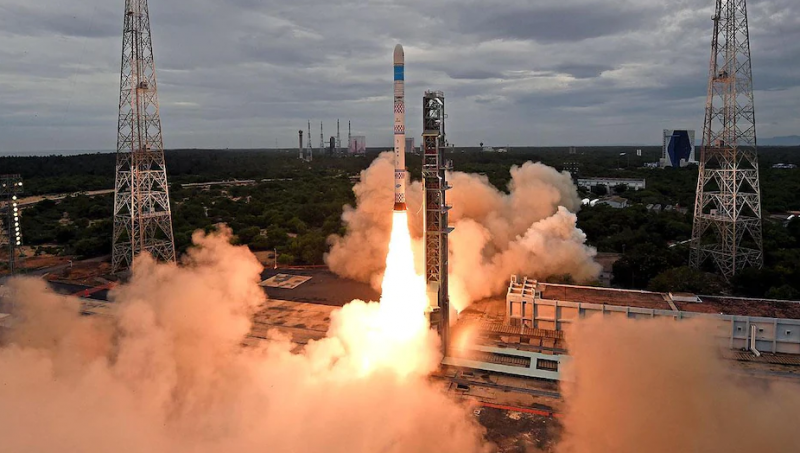
New Delhi: The Indian Space Research Organisation (ISRO) launched India's new rocket Small Satellite Launch Vehicle on August 7, 2022. But the rocket was not completely successful. He put both satellites in an elliptical orbit instead of putting them in a circular orbit. ISRO chief S Somanath gave the reason for this. S Somanath said that there was some disturbance in the rocket accelerometer for 2 seconds. Due to this, the rocket put both satellites EOS-2 and AzaadiSAT in an elliptical orbit of 356 x 76 kilometres instead of a circular orbit of 356 kilometres. Now, these satellites are of no use. Because they are not able to contact. This error was caused by the failure of a sensor. Due to this the direction and speed of the rocket changed at the last moment.
SSLV three-stage rocket that runs entirely on solid propellant. It is designed to deploy satellites weighing up to 500 kg in orbit. The ISRO chief said that all of us scientists are ready for many types of failures. In any mission, success and failure are seen together. The accelerometer and its sensors monitor the speed of the rocket. Control him. If the accelerometer had failed, it could have happened at the time of launch. But he brought the rocket far above the right. But after that, there was some change in his calculations. In the three-stage rocket, there is a satellite on the third stage. As soon as it separated from the second stage, that disturbance was recorded for two seconds. The internal computer in the rocket realized this. So he started the salvage operation meaning he started the rescue process. Somnath again said that in the rescue process, the internal computer starts open loop guidance instead of closed loop guidance. The computer also knows its process in advance. He does not allow the rocket to deviate from its path. But once open loop guidance starts, the chances of satellites reaching the right orbit are reduced. In such a situation, the internal computer gives the command that now we can not go forward until the next stage fires. In some way, the satellite will have to be separated from the third stage. The third stage of SSLV is not a liquid stage. This is a solid stage. It is not possible to stop it in the middle of the road. The computer in the rocket waits that this problem has occurred in the second stage, so the problem can end when the third stage starts. He waits till the firing of the third stage is completed. As soon as the firing of the third stage was completed, he left the rockets in space. SSLV did that. SSLV left the satellites in orbit, but there was a small deficiency in this process. Because the speed was reduced. If the speed of putting satellites in orbit should be 7.3 kilometres per second. The rocket achieved a speed of 7.2 km per second. Now it was feeling deficient at the rate of 40, 50 or 60 meters per second. We had to put it in a circular orbit but due to this decrease in speed, the perigee became 76 kilometres. Somnath said that if the satellite goes into the elliptical orbit instead of the circular, then there is a drag in it. That is, there is atmospheric drag. This makes the satellite come down very fast. Around 20 minutes the satellite leaves its orbit. This is what happened with the satellites left by SSLV. I can't say that the mission failed completely. But yes, there was a failure.
Somnath said that the rocket did the right thing. All his stages were working fine. The propulsion system was working correctly. When the rocket's accelerometer went awry, the rocket's computer thought I would save the rocket. It also started the rescue process, due to which the satellites went into the wrong orbit. This means that there was no glitch in the accelerometer because they pushed the rocket forward even after that. The computer has found a glitch left in the accelerometer, which is currently beyond our understanding. Or there is a problem with the sensor. The rocket computer said that there was a two-second disturbance in the accelerometer. After this, he recovered. But the computer made these two seconds guilty. PSLV i.e. Polar Satellite Launch Vehicle is a 44-meter long and 2.8-meter diameter rocket. Whereas, the length of SSLV is 34 meters. Its diameter is 2 meters. PSLV has four stages. While SSLV has only three stages. PSLV weighs 320 tonnes, while SSLV weighs 120 tonnes. PSLV can carry a payload weighing 1750 kg up to 600 km. SSLV can carry payloads of 10 to 500 kg up to 500 km. PSLV is ready in 60 days. SSLV is ready in just 72 hours. At present, SSLV will be launched from launch pad 1 of Satish Dhawan Space Center in Sriharikota. But after some time, a separate Small Satellite Launch Complex (SSLC) will be built here for the launch of this rocket. After that, a new spaceport is coming up at Kulasekarapatnam in Tamil Nadu. Then there will be the launch of SSLV.
'American Companies in Bangalore bolstering US-India economic ties'
Woman killed entire family one by one, know about this shocking case
'Laal Singh Chaddha' movie sparks row at Delhi's Vegas mall, slogans raised against Aamir Khan